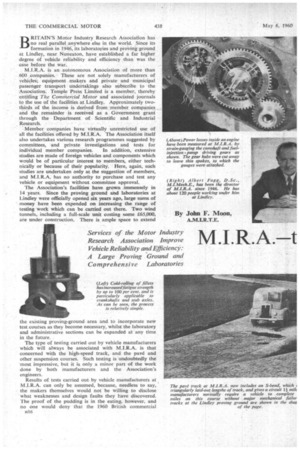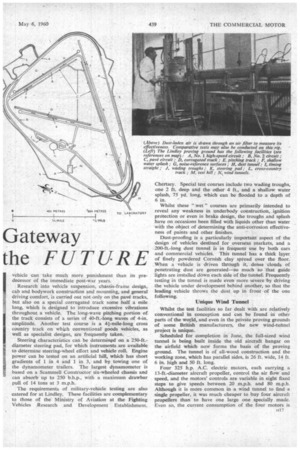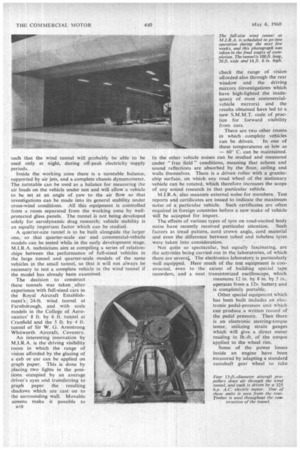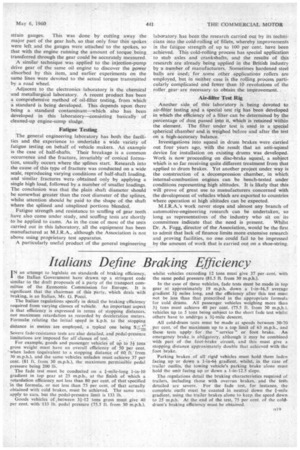M.I.R.A.- - t
Page 130

Page 131

Page 132

Page 133

If you've noticed an error in this article please click here to report it so we can fix it.
Gateway
the FUTURE BRITAIN'S Motor Industry Research Association has no real parallel anywhere else in the• world. Since its formation in 1946, its laboratories and proving ground at Lindley, near Nuneaton, have established a far higher degree of vehicle reliability and efficiency than was the ease before the war.
M.I.R.A. is an autonomous Association of more than 600 ,companies. These are not solely manufacturers of vehicles; equipment makers and private and municipal passenger transport undertakings also subscribe to the Association. Temple Press Limited is a member, thereby entitling The Commercial Motor and associated journals to the use of the facilities at Lindley. Approximately twothirds of the income is derived from .member companies and the remainder is received as a Government grant through the Department of Scientific and Industrial Research.
Member companies have virtually unrestricted use of all the facilities offered by M.I.R.A. The Association itself also undertakes various research programmes suggested by committees, and private investigations and tests for individual member companies. In addition, extensive studies are made of foreign vehicles and components which would be of particular interest to members, either technically or because of their popularity. Here, again, such studies are undertaken only at the suggestion of members, and M.I.R.A. has no authority to purchase and test any vehicle or equipment without committee approval.
The Association's facilities have grown immensely in 14 years. Since the proving ground and laboratories at Lindley were officially opened six years ago, large sums of money have been expended on increasing the range of testing work which can be carried out there_ Two wind tunnels, including a full-scale unit costing some £65,000, are under construction. There is ample space to extend the existing proving-ground area and to incorporate new test courses as they become necessary, whilst the laboratory and administrative sections can be expanded at any time in the future.
The type of testing carried out by vehicle manufacturers which will always be associated with M.I.R.A. is that concerned with the high-speed track, and the pave and other suspension courses. Such testing is undoubtedly the most impressive, but it is only a minor part of the work done by both manufacturers and the Association's engineers.
Results of tests carried out by vehicle manufacturers at M.I.R.A. can only be assumed, because, needless to say, the makers themselves would not be willing to disclose what weaknesses and design faults they have discovered. The proof of the pudding is in the eating, however, and no one would deny that the 1960 British commercial H16 vehicle can take much more punishment than its predecessor of the immediate post-war years.
Research into vehicle suspension, chassis-frame design, cab and bodywork construction and mounting, and general driving comfort, is carried out not only on the pave tracks, but also on a special corrugated track some half a mile long, which is designed to introduce excessive vibrations throughout a vehicle. The long-wave pitching portion of the track consists of a series of 40-ft-long waves of 4-in. amplitude. Another test course is a 41-mile-long cross country track on which conventional goods vehicles, as well as specialist designs, are frequently taken, Steering characteristics can be determined on a 250-ft--• diameter steering pad, for which instruments are available to determine steering-wheel effort and vehicle roll. Engine power can be tested on an artificial hill, which has short gradients of 1 in 4 and 1 in 3, and by towing one of the dynamometer trailers. The largest dynamometer is based on a Scanamell Constructor six-wheeled chassis and can absorb up to 250 b.h.p., with a maximum drawbar pull of 14 tons at 3 m.p.h.
The requirements of military-vehicle testing are also catered for at Lindley. These facilities are complementary to those of the Ministry of Aviation at the Fighting Vehicles Research and Development Establishment. Chertsey. Special test courses include two wading troughs, one 2 ft. deep and the other 4 ft., and a shallow water splash, 75 yd. long, which can be flooded to a depth of 6 in.
Whilst these " wet " courses are primarily intended to reveal any weakness in underbody construction, ignition protection or even in brake design, the troughs and splash have on occasions been filled with liquids other than water with the object of determining the anti-corrosion effectiveness of paints and other finishes.
Dust-proofing is a particularly important aspect of the design of vehicles destined for overseas markets, and a 200-ft.-long dust tunnel is in frequent use by both cars and commercial vehicles. This tunnel has a thick layer of finely powdered Cornish clay spread over the floor. When a vehicle is driven through it, dense clouds of penetrating dust are generated—so much so 'that guide lights are installed down each side of the tunnel. Frequently testing in the tunnel is made eVen more severe by driving the vehicle under development behind another, so that the leading vehicle throws the dust up in frOnt of the one following.
Unique Wind Tunnel Whilst the test facilities so far dealt with are relatively conventional in conception and can be found in other parts of the world, and even in the private proving grounds of some British manufacturers, the new wind-tunnel project is unique.
Scheduled for completion in June, the full-sized wind tunnel is being built inside the old aircraft hangar on the airfield which now forms the basis of the proving ground. The tunnel is of all-wood construction and the working zone, which has parallel sides, is 26 ft. wide, 14 ft. 6 in. high and 50 ft. long.
Four 325 h.p. A.C. electric motors, each carrying a 13-ft-diameter aircraft propeller, control the air flow and speed, and the motors' controls are variable in eight fixed steps to give speeds between 20 m.p.h. and 80 m.p.h. Although it is more common in a wind tunnel to find a single propeller, it was much cheaper to buy four aircraft propellers than to have one large one specially made. Even so, the current consumption of the four motors is
such that the wind tunnel will probably be able to be used only at night, during off-peak electricity supply periods.
Inside the working zone there is a turntable balance, supported by air jets, and a complete chassis dynamometer. The turntable can be used as a balance for measuring the air loads on the vehicle under test and will allow a vehicle to be set at an angle of yaw to the air flow so that investigations can be made into its general stability under cross-wind conditions. All this equipment is controlled from a room separated from the working zone by wellprotected glass panels. The tunnel is not being developed solely for aerodynamic drag research; vehicle stability is an equally important factor which can be studied.
A quarter-size tunnel is to be built alongside the larger one, so that quarter-scale car and commercial-vehicle models can be tested while in the early development stage. M.I.R.A. technicians aim at compiling a series of relationships between the performance of full-sized vehicles in the large tunnel and quarter-scale models of the same vehicles in the small tunnel, so that it will not always be necessary to test a complete vehicle in the wind tunnel if the model has already been examined.
The decision to construct these tunnels was taken after experience with full-sized cars in the Royal Aircraft Establishment's 24-ft. wind tunnel at Farnborough, and with scale Models in the College of Aeronautics' 8 ft. by 6 ft. tunnel at Cranfield and the 5 ft. by 4 ft. tunnel of Sir W. G. Armstrong Whitworth Aircraft, Coventry.
An interesting innovation by M.I.R.A. is the driving visibility room in which the range of vision afforded by the glazing of a cab• or car can be applied on graph paper. This is done by placing two lights in the positions occupied by an average driver's eyes and transferring to graph paper the resulting shadows which are cast on to the surrounding wall. Movable ;ereens make it possible to check the range of vision afforded also through the rear window and the driving mirrors (investigations which have high-lighted the inadequacy of most commercialvehicle mirrors) and the results obtained have led to a new S.M.M.T. code of practice for forward visibility from cars.
There are two other rooms in which complete vehicles can be driven. In one of these temperatures as low as — 60° C. can be maintained.
In the other vehicle noises can be studied and measured under "free field" conditions, meaning that echoes and sound reflections are absorbed by the floor, ceiling and walls themselves. There is a driven roller with a granitechip surface, on which any road wheel of the stationary vehicle can be rotated, which therefore increases the scope of any sound research in that particular vehicle.
M.I.R.A. also measure external noise for members. Test reports and certificates are issued to indicate the maximum noise of a particular vehicle. Such certificates are often required in foreign countries before a new make of vehicle will be accepted for import.
The effects of various types of tyre on road-excited body noise have recently received particular attention. Such factors as tread pattern, cord crown angle, cord material and even the difference between tubed and tubeless tyres were taken into consideration.
Not quite so spectacular, but equally fascinating, are the activities being carried out in the laboratories, of which there are several, The electronics laboratory is particularly well equipped. Here much of the test equipment is constructed, even to the extent of building special tape recorders, and a neat transistorized oscilloscope, which measures 12 in. by 8 in. by 5 in..
operates from a I2v. battery and is completely portable.
• Other special equipment which has been built includes an electronic pedal-pressure unit which can produce a written record of the pedal pressure. Then there is an electronic steering-torque tester, utilizing strain gauges which will give a direct meter reading in lb.-ft. of the torque applied to the wheel rim.
Some of the power losses inside an engine have been measured by adapting a standard camshaft gear wheel to take strain gauges. This was done by cutting away the major part of the gear hub, so that only four thin spokes were left and the gauges were attached to the spokes, so that with the engine running the amount of torque being transferred through the gear could be accurately measured.
A similar technique was applied to the injection-pump drive gear of the same oil engine to discover the power absorbed by this item, and earlier experiments on the same lines were devoted to the actual torque transmitted by a road wheel.
Adjacent to the electronics laboratory is the chemical and metallurgical laboratory. A recent product has been a comprehensive method of oil-filter testing, from which a standard is being developed. This depends upon there being a standard contaminant—which also has been developed in this laboratory—consisting basically of cleaned-up engine-sump sludge.
Fatigue Testing The general engineering laboratory has both the facilities and the experience to undertake a wide variety Of fatigue testing on behalf of vehicle makers. An example is the case of half-shafts. Their breakage is a common occurrence and the fracture, invariably of conical formation, usually occurs where the splines start. Research into the cause of this type of fracture was conducted on a wide scale, reproducing varying conditions of half-shaft loading, and similar fractures were obtained only by applying a single high load, followed by a number of smaller loadings. The conclusion was that the plain shaft diameter should be somewhat greater than the root diameter of the splines, whilst attention should be paid to the shape of the shaft where the splined and utisplined portions blended.
Fatigue strength and resistance to scuffing of gear teeth have also come under study, and scuffing tests are shortly to be applied to cams. As in the case of most of the tests carried out in this laboratory, all the equipment has been manufactured at MJ.R.A., although the Association is not above using proprietary test apparatus.
A particularly useful product of the general engineering laboratory, has been the research carried out by its technicians into the cold-rolling of fillets, whereby improvements in the fatigue strength of up to 100 per cent. have been achieved. This cold-rolling process has special application to stub axles and crankshafts. and the results of this research are already being applied in the British industry by a number of manufacturers. Sometimes hardened steel balls are used for some other applicatiOns rollers are employed, but in neither case is the rolling process particularly complicated and fewer than 10 revolutions of the roller, gearare necessary to obtain the improvement.
Air-fiitEr Test Rig , Another side, of this laboratory is being devoted to air-filter testing and a Special test rig has been developed in which the efficiency of a filter can be determined by the percentage of dust passed into it _which is retained within the element. The filter under test is used in a special spherical chamber and is weighed before and after the test on a high-accuracy balance.
Investigations into squeal in drum brakes were carried out four years ago, with the result that an anti-squeal device for installation on existing drums was developed. Work is now proceeding on disc-brake squeal, a subject which is so far receiving quite different treatment from that applied to drum brakes. Yet another project under way is the construction of a decompression chamber, in which internal-combustion engines can be bench-tested under conditions representing high altitudes. It is likely that this will prove of great use to manufacturers concerned with the development of vehicles which are exported to countries where operation at high altitudes can be expected.
M.I.R.A.'s work never stops and almost any branch of automotive-engineering research can be undertaken, so long as representatives of the industry who sit on its committees indicate that the need is present. Whilst Dr. A. Fogg, director of the Association, would be the first to admit that lack of finance limits more extensive research and proving facilities, no one could fail to be impressed by the amount of work that is carried out on a shoe-string.




































































































































































































































































